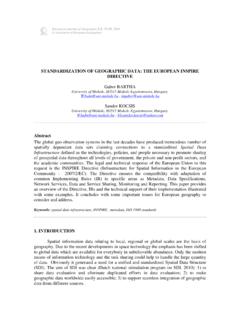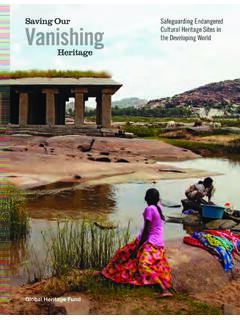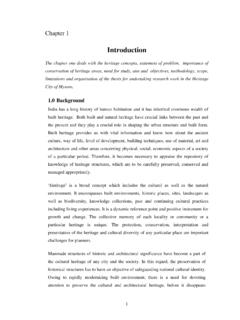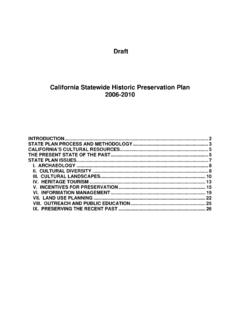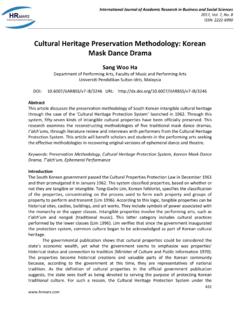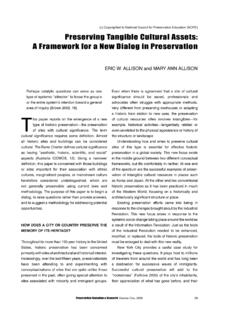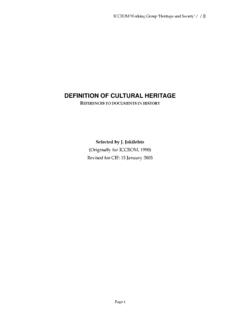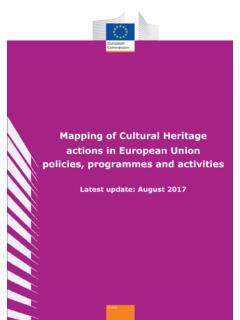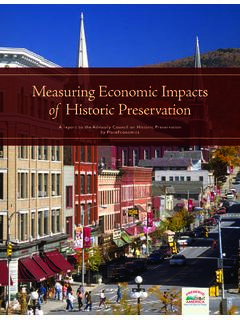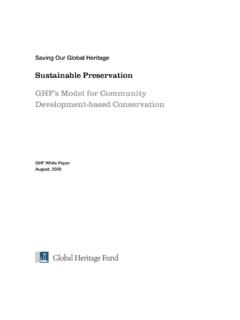Transcription of CULTURAL HERITAGE AND EDUCATION - …
1 European Journal of Geography Volume 5, Number 4:67-77, November 2014 Association of European Geographers CULTURAL HERITAGE AND EDUCATION . INTEGRATING TOUR MAPS IN A BILATERAL PROJECT Aikaterini P. APOSTOLOPOULOU University of the Aegean, Department of Geography, University Hill, Mytilene, 81100 Lu s Miguel CARVOEIRAS Escola B sica Integrada de Santa Maria, Rua Fernando Pessoa, Beja, 7800-181 Aikaterini KLONARI University of the Aegean, Department of Geography, University Hill, Mytilene, 81100 Abstract History and Geography as school subjects are inter-related in formal or non formal liaisons in European national curricula. This paper presents the case of a primary school from Greece and two secondary schools from Portugal and Sweden that collaborated in a bilateral European project under the title Mapping our city monuments.
2 After the selection of significant monuments and bibliographical research, students organized guided tours using GPS devices and digital cameras. Following the field trips Maps Tours were created on ArcGIS Online, myHisto website and Google Maps, integrating collected photographs and data from the site. The use of digital maps in EDUCATION designed by students leaded to the rediscovery of historical and archaeological monuments in urban settings linking spatial thinking to CULTURAL recognition. Thus the suggested didactical approach promotes spatial citizenship and CULTURAL preservation through innovative pedagogical practices. Keywords: Geography EDUCATION , HERITAGE EDUCATION , ArcGIS Online, myHistro, Google Maps 1.
3 INTRODUCTION CULTURAL HERITAGE is a group of resources inherited from the past which people identify, independently of ownership, as a reflection and expression of their constantly evolving values, beliefs, knowledge and transitions. It includes all aspects of the environment resulting from the interaction between people and places through time (Council of Europe, 2005). The definition adopted by the Faro Convention differentiates from the concept of CULTURAL HERITAGE as a traditional notion of protection or conservation of single monuments, archaeological sites, group of historical buildings, landscape or historic town centres. The Convention promotes citizen participation in decision making and management processes related to the CULTURAL environment.
4 This consideration was adopted by the 2014 Conference HERITAGE First! Towards a Common Approach for Sustainable Europe organized by the Hellenic Precidency of the Council of the It is suggested that HERITAGE should be enhanced and promoted as a driving force for active engagement and social responsibility 67 Apostolopoulou , Carvoeiras , Klonari A. /European Journal of Geography 5 4 (2014) while consisting a resource and prerequisite for a Europe of smart, sustainable and inclusive growth (Hellenic Presidency of the Council of the European Union, 2014) Formal EDUCATION addresses the aspect of public participation and involvement.
5 The CULTURAL HERITAGE dimension is suggested to be included at all levels of EDUCATION , not particularly as a core subject but through interdisciplinary actions (Faro Convention, Article 13). Furthermore the Faro Convention fosters multilateral co-operations for the recognition of the common HERITAGE of Europe (Faro Convention, Article 17). Raising awareness and promoting the value and role of CULTURAL HERITAGE is integrated in several European curricula of History and Geography. In the Greek Curriculum for Primary EDUCATION among the general goals for the lesson of History the following are inter-related with HERITAGE EDUCATION : a) experiential learning of aspects of culture such as traditions, customs etc.
6 , b) contact with CULTURAL HERITAGE , c) appreciation of CULTURAL HERITAGE , d) identification of the contribution of the Europe to the world culture and of the value of world peace and collaboration (Official Gazette, 2003a). For the lesson of Geography the general goals that are linked with HERITAGE EDUCATION are: a) study of the interaction between physical environment and people and b) cultivation of attitudes and behaviours that allow regular and creative integration to the natural and socio- CULTURAL environment (Official Gazette, 2003b). According to the new programs for Geography, emphasis is given to research through school projects that focus on local issues with the use of GIS and ICT (Klonari, 2013).
7 In Portugal the HERITAGE concept is dealt with in depth mainly in History. However we can find some references in Geography s curriculum such as pupils must be able to interpret and analyse critically the geographic information and understand the territorial identity, CULTURAL , HERITAGE and regional individuality, allow him to strengthen the sense of belonging to his country and the capacity of civic action (DEB, 2002). In History we can find a clearer HERITAGE learning sequence. Pupils between six and nine years old are expected to recognize and valorise expressions of the CULTURAL and historic HERITAGE on their region. Pupils between ten and eleven years old must be able to explain and valorise the elements of the Portuguese historic HERITAGE .
8 Finally, pupils between twelve and fourteen years old must be able to integrate and valorise the elements of the Portuguese historic HERITAGE in the context of world historical HERITAGE (DEB, 2001). The development of geographical media and ICT offers new possibilities to teachers to create engaging contexts for learning. Cloud computing has expanded educational resources providing the opportunity for sharing maps, Figures, video, data, visualizations (Donert, 2014). In a recent publication of the Digital-Earth Network, on-line GIS were applied in examples of geo-media implementations in different ages and subject areas including HERITAGE EDUCATION (Donert and Parkinson, 2013).
9 ETwinning is a European program supported by the European Commission that promotes collaboration and school networking with the use of ICT. The eTwinning portal is a multilingual website that offers collaboration tools and services to teachers to create partnerships and collaborative projects in several subject areas (EACEA, 2013). Therefore the eTwinning platform fosters multilateral co-operations in the field of HERITAGE EDUCATION and geo-media and offers opportunities for the creation of a European identity. European identity does not occur by itself; rather it is a result of positive experiences, a sense of belonging and acceptance in a common European area (Resnik Planinc, 2013).
10 Taking under consideration the possibilities that on-line GIS offers for the promotion of CULTURAL HERITAGE and the active engagement of students in inquiry based learning activities the Intercultural Primary School in Alsoupoli, Greece along with Hjortsbergskolan from Sweden and Escola B sica Integrada de Santa Maria in Beja, Portugal decided to collaborate on the development of an eTwinning project under the title Mapping our City Monuments . The purpose of the project was mapping historical and archaeological monuments of our cities 68 Apostolopoulou , Carvoeiras , Klonari A.

